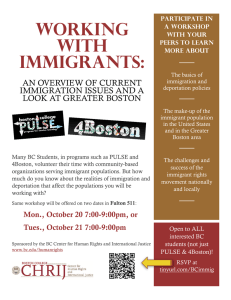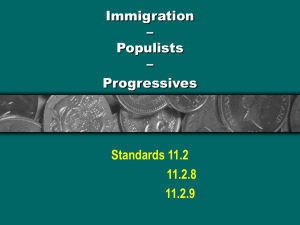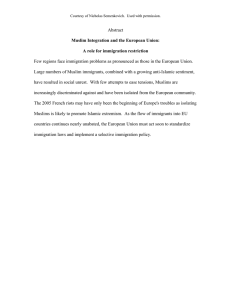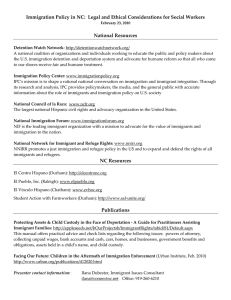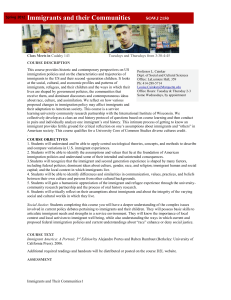Week Fourteen
advertisement
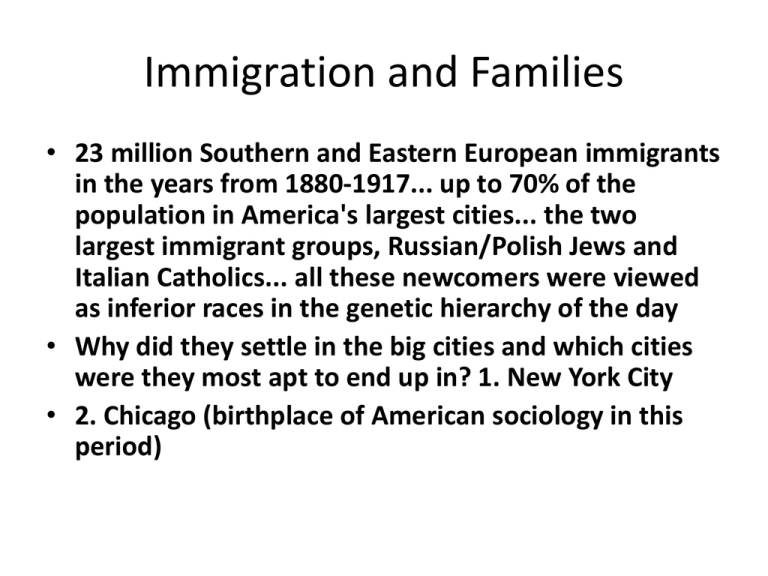
Immigration and Families • 23 million Southern and Eastern European immigrants in the years from 1880-1917... up to 70% of the population in America's largest cities... the two largest immigrant groups, Russian/Polish Jews and Italian Catholics... all these newcomers were viewed as inferior races in the genetic hierarchy of the day • Why did they settle in the big cities and which cities were they most apt to end up in? 1. New York City • 2. Chicago (birthplace of American sociology in this period) Anti-immigrant reaction by the time of World War I • Theories of genetic inferiority: smaller heads, shorter stature, lower IQ scores • Widespread testing of those becoming soldiers • After the War: the Immigration Act of 1924 set a yearly quota of 2% of the number of a nationality present in 1890 Immigration Act of 1965 • Immigration based on 1) family already in the United States, and 2) job skills needed in the U.S. economy • Also a large amount of undocumented immigration, particularly from Latin American Countries. • Why do they come? Think about Siler City (“Matters of Race: the Divide”) Aldarondo and Ameen: “The Immigration Kaleidoscope” Two premises: 1. We Are all stakeholders in the well-being of immigrant families. 2. We pay a high price for not knowing the facts about immigration. Immigrant woman at hotel counter: “I worry we are losing hope… We are a hard-working people and they think we are here to do nothing… How could it be that they don’t see that we are here to work, that we are good people?> Immigration statistics • 2006: Immigrants and the children of immigrants, 60 million, more than 2/3 here legally • What do we think about the ones that are not? Mexican-American War and its effect on my attitudes… (Henry David Thoreau: wouldn’t pay taxes because of this war and the laws about the return of escaped slaves) Why the rising tide of anti-immigrant settlement? • A&A think it relates to the increased movement of immigrants to small towns (like Siler City) and to suburbs, where they are much more visible (rather than in what amount to almost immigrant ghettos in large cities) Acculturation • 80% of immigrant families (first generation) speak a language other than English at home. • Still, high levels of English use. E.g., California census data show that 71% of Latino families and 89% of Asian families speak English very well, and immigrant kids achieve college degrees in about the same proportion as their native-born peers Other Positives factors • Higher marriage rates and lower divorce rates • Children 50% more likely to be living with both parents • Larger households, which can probably be both a plus and a minus • Portes and Rimbaut study in San Diego and Miami: the immigrant children with selective acculturation have the best adjustment Immigrant perceptions of life in America • Mostly positives: see 242-243 • Notice that many immigrants keep close contact with friends and relatives in their native country and send money back. Strong work ethic, commitment to learning English, important to become a citizen, to serve in the military, to volunteer for military service. • Negatives: 53% believe immigrants as a group are not treated well by Americans; 68% indicated that Americans are not nice to each other (what can this mean?) Video: “Daddy and Papa”



